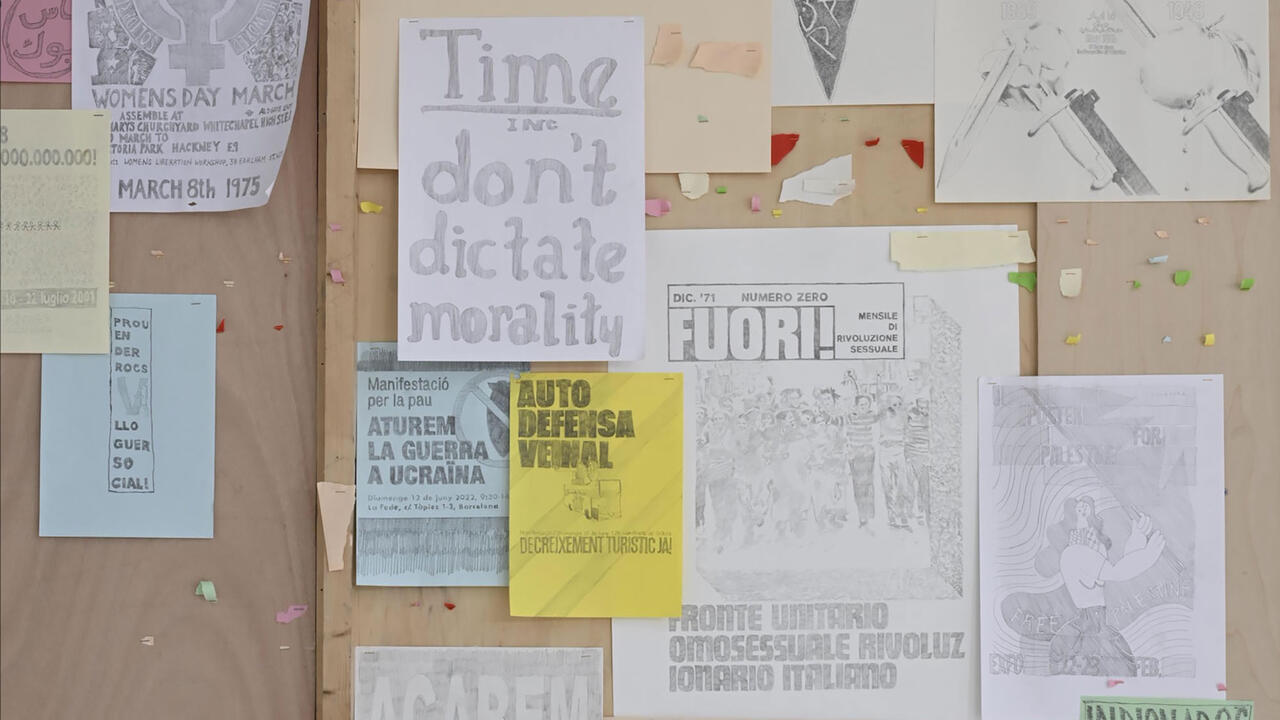Daniel G. Andújar’s Vision for the Future of Work
The artist’s new works at La Virreina, Barcelona, predict that the culture industry will never be automated
The artist’s new works at La Virreina, Barcelona, predict that the culture industry will never be automated

In 1996, Daniel G. Andújar, an early proponent of net art, founded Technologies To The People: a mock corporation that marketed advanced technology to the underprivileged while spoofing the visual tics and ersatz transparency of digital brands. Largely focusing on projects from the last five years, the artist’s current exhibition at La Virreina Centre de la Imatge reveals that this double-edged concern with class hierarchies and utopian promises is still relevant today. Titled ‘The Third Estate’ – in reference to the medieval European term for common people – the show conflates past ideological struggles with the present and future of work, collective culture and propaganda.
In the first gallery, the phrase ‘this is not a worker’ has been written on the wall by a robotic plotter. Futurologists have predicted that almost half the jobs in high-wage economies are at risk of being replaced by automation and artificial intelligence within the next 20 years. Robot Scribit (2020) seems to ask – with reference to René Magritte’s The Treachery of Images (1929) – whether our anxiety about the future relates less to new technology per se than to our search for someone to blame for this very sense of foreboding. Karl Marx looms large: The Communist Manifesto (2019) is a disconcerting video simulation of the philosopher’s head as he reads his revolutionary 1848 analysis of capitalist modes of production like a silken-voiced, radical-policymaking Alexa.

The central gallery is dominated by Protected Canon – The Disasters of War: Trojan Horse (2017), a group of faux classical sculptures secured within wall-less wooden crates, and Master Pieces – Hack the Museum: The People’s Museum (2017–18), a series of more than 30 printed reproductions of famous paintings. The former references the efforts of republicans and antifascists to safeguard Spain’s artistic heritage following the outbreak of civil war in 1936, while the latter encompasses six centuries of Western art history. Masterpieces such as Henri Matisse’s Dance (1909–10) or Diego Velázquez’s Las Meninas (1656) are so recognizable that they have ascended from the status of mere artworks to that of world image heritage, progressing upwards into the cloud on museum servers or data banks such as Google Cultural Institute. Whether slack on their stretchers like placards or, as with the replica of Pablo Picasso’s Guernica (1937), hanging from a rail like an agitprop backdrop, these glossy facsimiles seem strangely poised for troublemaking. This ultra-populist vision of a museum is, at once, a knock-off souvenir nightmare and an ironic salvation scenario for art that is beholden to expert culture and the supremacy of authenticity.

History of Workers (2020) is a series of 25 robotic-plotter drawings that bootlegs posters, stencils and slogans related to global labour movements, from Black liberation, through student protests, to the recent meme: ‘I am an artist … thank you for understanding.’ Albatera Concentration Camp (2019) embodies a more subdued though no less potent form of activism. Composed of archival footage and contemporary drone shots, the video draws attention to a little-known Spanish prison where tens of thousands of people died between 1937 and 1939 – among them, trade unionists, writers and artists.

The final gallery featuring Battle Cry (2019) – a plotter-drawn collection of historical political slogans and their unctuous contemporary echoes, including ‘Deus, Pátria e Familia’ (God, Fatherland and Family), a time-worn fascist motto recently adopted by Jair Bolsonaro – is a highlight. Fittingly, for an exhibition that champions the collective, ‘The Third Estate’ is most compelling when treated as a group effort rather than as individual works. The future of employment suggests that, if your work can easily be explained, it can be automated. Operating inscrutably between hacker and historian, satirist and folklorist, Andújar creates a critical supply and demand where artists evidently won’t be out of a job.
Daniel G. Andújar, ‘The Third Estate’ is on view at La Virreina Centre de la Imatge, Barcelona, until 27 September 2020.
Main image: Daniel G. Andújar, Pyramid of Capitalism, 2019, oil on canvas, 1.9 × 1.6 m. Courtesy: the artist and Àngels Barcelona






















